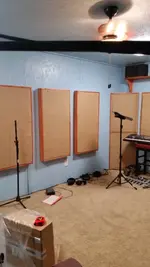Nola
Well-known member
I have read a lot of bad reviews of it.
My problem is probably the same as most here. The walls are dry wall material and kind of hollow sounding if you knock on them. When I clap it's a lot of that harsh sounding reverb/combing. The floor has carpet. The ceiling is gross tactic material, not sure what it is. I just want to make it more usable, not have a pro studio. I read about acoustic cotton, and it seems intriguing. Is that better than the foam? I can't make fiberglass traps due to the lease terms. I'm not even sure I'd be able to hang acoustic cotton, depending how you mount it.
What's the best way to just get rid of that comb filtering/echo when clapping. It has to be aesthetic b/c this room doubles as a living room. thanks
My problem is probably the same as most here. The walls are dry wall material and kind of hollow sounding if you knock on them. When I clap it's a lot of that harsh sounding reverb/combing. The floor has carpet. The ceiling is gross tactic material, not sure what it is. I just want to make it more usable, not have a pro studio. I read about acoustic cotton, and it seems intriguing. Is that better than the foam? I can't make fiberglass traps due to the lease terms. I'm not even sure I'd be able to hang acoustic cotton, depending how you mount it.
What's the best way to just get rid of that comb filtering/echo when clapping. It has to be aesthetic b/c this room doubles as a living room. thanks






